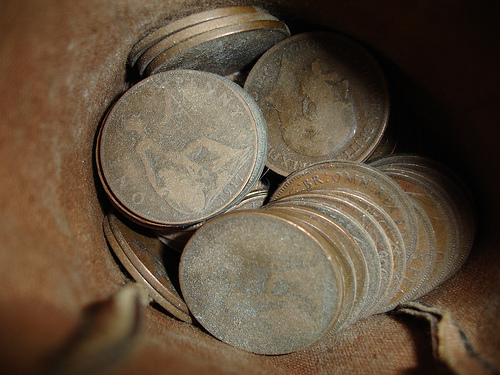
As We Buy and sell Pre-decimal coins every day and are always getting ask questions about our old money.
So here is a page to answer some of the most popular questions.
Pre-decimal money was based on the following;
12 pennies (d) to 1 shilling,
20 shillings to the pound (£)
so in turn there was 240 pennies (d) in the pound.
Pre-decimal currency was sometimes called LSD, which was written £-s-d. The pound symbol is an ornate L, from the Latin 'libra' - a pound. The penny symbol was 'd' for denarius, a Roman coin.
| L.S.D. (pounds, shillings and pence) | Decimal Equivalent |
|---|---|
| Farthing (quarter of an old penny) | 10 per 1 p |
| Ha'penny (half an old penny) | 5 per 1 p |
| Penny | 2 and a half per 1 p |
| Thruppence (threepenny bit) | Slightly over 1 p |
| Sixpence (tanner) | 2.5 p |
| Shilling (bob) | 5 p |
| Florin (two bob) | 10 p |
| Half crown | 12.5 p |
| Ten Shilling Note (ten bob note) | 50 p |
| £1 Note | 100 p |
Slang for British Money
Some pre-decimalisation coins or denominations became commonly known by slang terms, perhaps the most well known being bob for a shilling, and quid for a pound. A farthing was a mag, a silver threepence was a joey and the later aluminium-bronze threepence was called a threepenny bit (pronounced threp'ny bit), a sixpence was a tanner , the two-shilling coin or florin was a two-bob bit, and the two shillings and sixpence coin or half-crown was a half dollar.
| Slang term | Amount |
| tanner | sixpence - pre decimalisation |
| bob | a shilling - pre decimalisation |
| Oxford | 5 shillings or a crown [cockney rhyming slang = Oxford Scholar] |
| nicker or quid | £1 |
| lady | £5 (fiver). [cockney rhyming slang = Lady Godiva] |
| tenner | £10 |
| score | £20 [cockney rhyming slang = apple core ] |
| pony | £25 |
| ton | £100 |
| monkey | £500 |
| grand | £1000 |